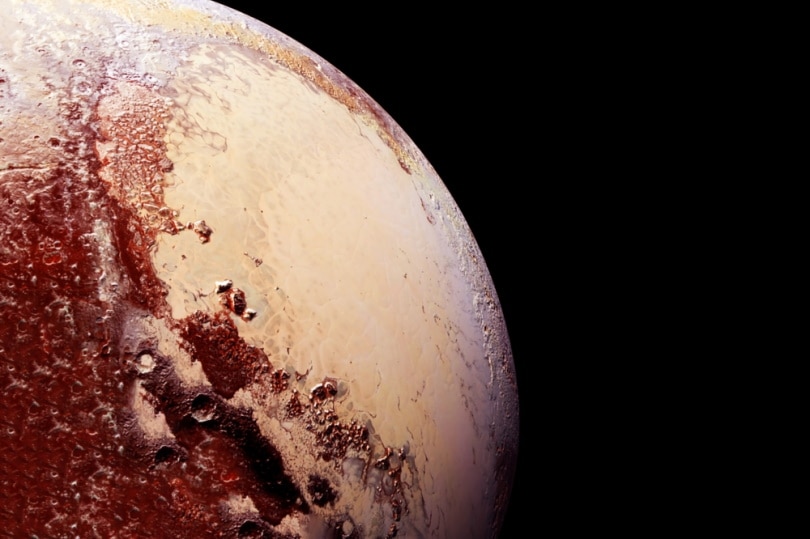Does Pluto Have Moons? What You Need to Know!
Last Updated on

Many people take for granted our moon and fail to do research about what a moon is and if moons impact other planets. In case you are unfamiliar, a moon is a natural satellite that orbits different planets in our Solar System. Whereas Earth only has one moon, there are over 200 moons in our Solar System.
Are there any moons around Pluto, though? Despite Pluto being so small, it actually has a total of five moons, though Pluto’s moons are very small. Keep reading to learn more about Pluto’s moons.

Does Pluto Have Moons?
Like Earth, Pluto has at least one moon. Shockingly, Pluto actually has more moons than Earth, despite being notably smaller. It has a total of five moons, all of which are confirmed. Of all the dwarf planets, Pluto has the greatest number of moons.
The five moons of Pluto are named Charon, Hydra, Kerberos, Nix, and Styx. Of these five moons, Charon is the largest. It is about half the size of Pluto, making it the largest moon relative to its parent planet or dwarf planet in the solar system.
Scientists believe that a collision between Pluto and another object in the Kuiper Belt caused material to fly around and eventually form a family of satellites around the dwarf planet. This theory explains why Pluto has so many satellites.

When Were They Discovered?
Even though Pluto was discovered back in 1930, the moons weren’t discovered until years later.
Charon was the only moon to be discovered in the 1900s. It was discovered in 1978 at The US Naval Observatory in Flagstaff, Arizona. This observatory is only 6 miles away from where Pluto itself was discovered at the Lowell Observatory. Funnily enough, the astronomers weren’t looking for any moons. Instead, they were trying to perfect our understanding of Pluto’s orbit around the Sun.
The rest of the moons were not discovered until the 2000s. Their discoveries ranged from 2005–2012. Because these moons were discovered so late, they actually impacted the advancement of NASA’s New Horizons spacecraft.

How Do Pluto’s Moons Compare to Other Moons?
Throughout our Solar System, there are 158 confirmed moons and 56 provisional, resulting in a total number of 214 moons.
Of our Solar System’s eight planets, six have at least one moon. Mercury and Venus both have zero. Earth has one, and Mars has two. After Mars, the number of moons spikes.
Neptune has 14, and Uranus has 27. Jupiter has a total of 79 moons, 53 confirmed and 26 provisional. Meanwhile, Saturn has the highest number of moons at 82. Fifty-three of Saturn’s moons are confirmed and 29 are provisional.
As for dwarf planets, the dwarf planet Eris has one confirmed moon. When looking at dwarf planets alone, Pluto has the highest number of moons.

Recap
Even though Pluto is only considered a dwarf planet, it actually has five moons, although most of the moons are incredibly small. Still, Pluto has more moons than Mercury, Venus, Earth, and Mars. It also has more moons than any other dwarf planet.
Featured Image Credit: Artsiom P, Shutterstock
About the Author Robert Sparks
Robert’s obsession with all things optical started early in life, when his optician father would bring home prototypes for Robert to play with. Nowadays, Robert is dedicated to helping others find the right optics for their needs. His hobbies include astronomy, astrophysics, and model building. Originally from Newark, NJ, he resides in Santa Fe, New Mexico, where the nighttime skies are filled with glittering stars.
Related Articles:
15 Crucial Facts About Ultraviolet Rays & the Sun
What Constellation Is Spica In? The Interesting Answer!
10 Interesting Leo Constellation Facts, Myths, and FAQs
15 Interesting Pegasus Constellation Facts, Myths, and FAQs
6 Interesting Sagittarius Constellation Facts, Myths, and FAQs in 2024!
What Are Constellations? Where Did They Come From?
8 Interesting Libra Constellation Facts, Myths, and FAQs
What Is Infrared Radiation? Science-Based Facts & FAQ
